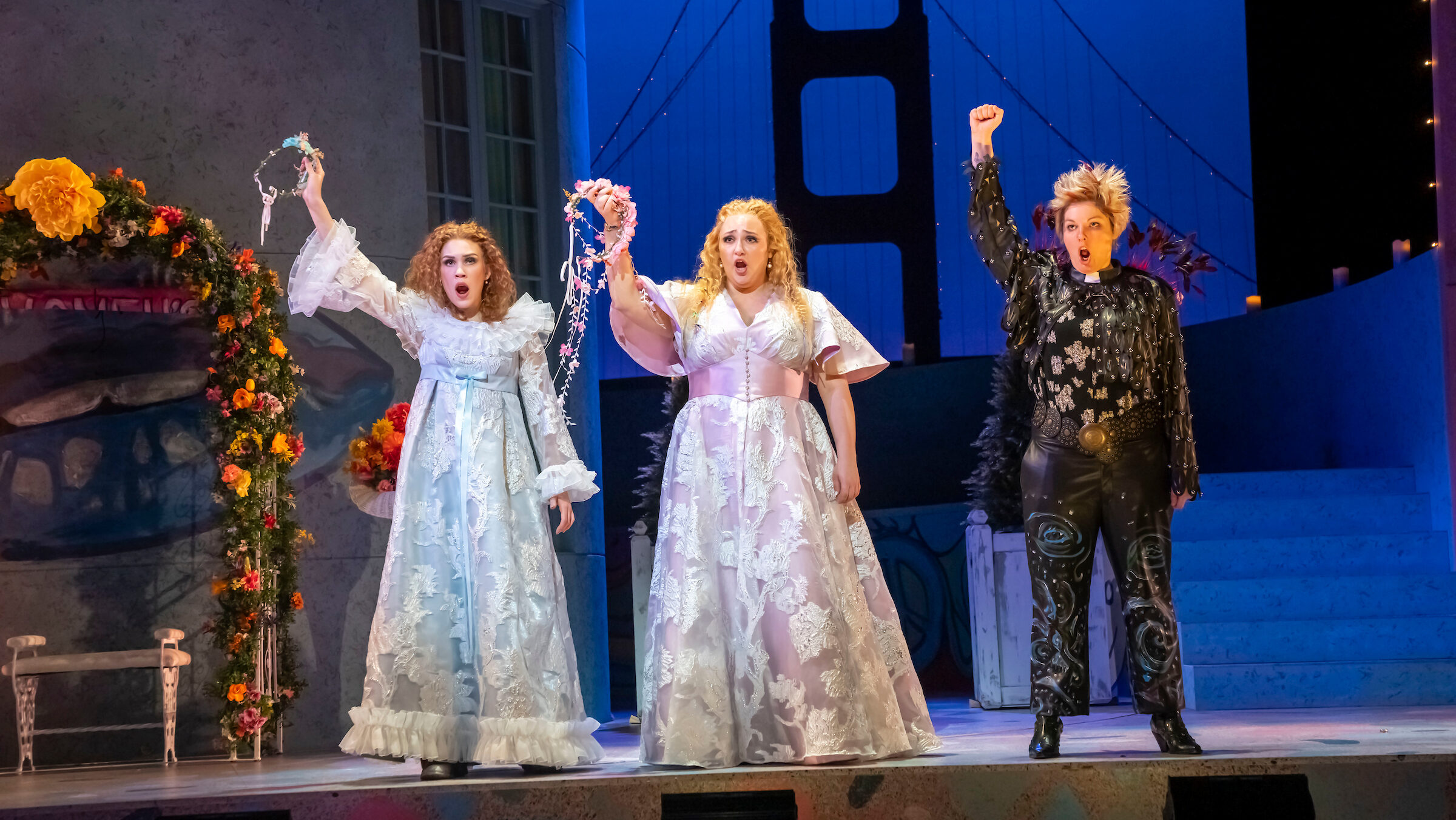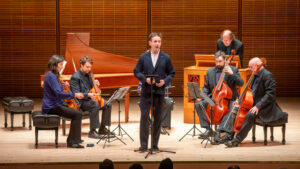

The opera was quickly refashioned as a five-act grand opera for Paris called Les Martyrs which premiered in 1840. The Italian version was finally performed in 1848 at the Teatro San Carlo in Naples (evidently they relaxed their religious censorship) and this more compact three-act Italian version quickly superseded Les Martyrs in popularity and public performances around the world.
It was a popular vehicle for the tenore robusto voice and noted exponents included the star tenors Carlo Baucardé, Enrico Tamberlik, Angelo Masini and Francesco Tamagno who kept the opera on the boards up and down Italy, Spain, Portugal and even South America.
Many of us have heard pirate recordings of the 1960 La Scala Poliuto revival headlined by the stellar trio of Maria Callas, Franco Corelli and Ettore Bastianini. In New York, it was performed in concert on May 4, 1998 by Opera Orchestra of New York under Eve Queler with Martile Rowland, Fabio Armiliato, Giovanni Meoni and Simone Alberghini.
In March 2016, the enterprising Amore Opera (successor to the Amato Opera of sainted memory) did a fully staged production at the Sheen Center downtown with a somewhat ragged volunteer orchestra.
Will Crutchfield in his interview mentioned how Verdi was influenced by the later Donizetti operas. Many of the musical and dramatic innovations generally attributed to Verdi (streamlining and editing out static vocal display and musical repeats in favor of forward-moving dramatic momentum and concision, etc.) actually were initiated by Donizetti in his mature operas of the 1830’s. The individual emotional conflicts contrasted against grand public spectacle of the Triumphal Scene in Aida are already there in the big finale of Act II of Poliuto.
So it was thrilling to see and hear Crutchfield’s insights come to life onstage in performance when Teatro Nuovo performed Poliuto at the Rose Theater at Jazz at Lincoln Center on Wednesday night July 19. Teatro Nuovo prides itself on being the only opera company in the United States that performs early 19th century bel canto operas in historical period style—meaning gut strings, natural horns, wooden flutes and with either (or both) the maestro al cembalo (i.e., the pianist) or the primo violino (concertmaster or first violin) leading the orchestra—not a separate conductor. The orchestra is placed on the same level as the audience on the orchestra level—not in a sunken pit.
The young Berlin-based conductor Jakob Lehmann led the orchestra for Poliuto on the violin from the podium. The edition of the score chosen by Teatro Nuovo was the original 1848 score with the only addition being the overture from Paris. The Teatro Nuovo orchestra seems to be freelance with a large number of young musicians—usually with any ensemble it takes a while for the players to coalesce and even more so without a regular conductor.
Initially things didn’t sound promising as the overture began with sour intonation, the tempos didn’t build musical impetus and the energy was low. As soon as the chorus entered things picked up and Lehmann led a convincing, well-integrated performance with greater polish and energy.
The cast was full of fresh, healthy youthful voices very carefully coached in the style and small details and intricacies of the score. Sensitive musicianship was the hallmark of the evening both onstage and in the orchestra.
Soprano Chelsea Lehnea was fiercely committed as Paolina, Poliuto’s estranged and emotionally conflicted wife. In her opening cavatina “Di quai soave lacrime”, Lehnea phrased like a virtuoso violinist with an acute understanding of where ornaments fit into the general flow of the phrase and how to use rubato expressively without distorting the music. However, it was evident from her program bio this is a young singer in the first steps of her career and some vocal issues need to be addressed.
The voice is naturally very high placed with excellent agility which she displayed in some high-flying ornamentation and climactic sopracuti. But the top notes can get fixed and shrill when pressure is applied and her middle and bottom registers do not match the top in fullness and color. Descents into the lower register produced some empty, guttural sounds.
However, Lehnea is both intensely musical and sensitive to dramatic situations—her face and body reacted vividly to Paolina’s tribulations making the character a major player in the drama. It also helps that she is tall and slim and looked lovely in a shimmering peach-gold off one shoulder gown. Some work needs to be done but the material is there and her abundant talent for operatic theater is evident (and she is young).

Severo’s music is full of macho bluster and aggression. If Rivera was a bit loud and louder in his vocalism, the tone was healthy and supple with solid tops (if a little opaque in color). Rivera has Carlo in Ernani and Miller in Luisa Miller coming up in Sarasota and early Verdi seems a natural fit for this juicy young voice.
The Argentine tenor Santiago Ballerini was introduced to local audiences by Crutchfield in Caramoor performances of Donizetti’s La Favorite and Bellini’s Il Pirata and also performed Argirio in Rossini’s Tancredi with Teatro Nuovo. Ballerini’s central repertory focuses on tenore di grazia roles like Ramiro in La Cenerentola, Nemorino in L’Elisir d’Amore and Conte Almaviva in Il Barbiere di Siviglia.
The title role in Poliuto is the most dramatic role he has performed to date. As composed for the aging French heroic tenor Adolphe Nourrit (he never got to perform the role publicly), the role of Poliuto centers on broad middle voice declamation with little in the way of florid ornamentation and only a few written high notes.
Though no Corelli in decibels, Ballerini had no difficulties with the exacting title role and his tone is naturally brilliant, warm and Italianate. He was very much the star of the evening. Ballerini’s broad breath span, intensely focused tone and brilliant overtones filled out the music beautifully and vividly delineated Poliuto’s conflict between marital jealousy and Christian devotion.
In the protagonist’s second act scena, Ballerini effectively enacted Poliuto’s emotional conflict by alternating between a sweet mezza voce and darker declamatory phrasing. Lehnea and Ballerini brought the Act III final duet to moving life with brilliant singing and sensitive and deeply committed interpretations.
Bass-baritone Hans Tashjian, a Teatro Nuovo regular (he was the intended Maometto Secondo this past Fall but couldn’t perform due to scheduling conflicts), proved a rather ineffective villain as the duplicitous High Priest Callistene.
Tashjian lacked resonance and power in the lower bass register and his tone sounded pale and etiolated. Some good coloratura, a sustained trill and one good high note suggest that this undeniably talented artist might want to focus on the baroque repertory—especially the early French baroque of Lully, Charpentier and Rameau.
All the supporting singers, like tenor Robert Kleinertz as the Christian leader Nearco, had good young voices and showed the benefits of expert coaching in language, diction and musical style by Crutchfield and his staff—the vowels were open and pure and the phrasing guided by sure musicianship.
All the singers were off book—no music stands or scores were in sight. Though the singers wore evening dress, there was some modest semi-staging and the singers sang and reacted to each other bringing the drama to life. An upstage screen displayed projections of 19th century engravings of scenic designs for the opera—catacombs, a Roman foyer, the temple of Jove, a prison cell and the arena—with English translations at the top. It was all very elegantly done (though I heard the English surtitles were not visible in the upper balconies of the Rose Theater).
The winners of the evening were Donizetti and the opera itself. Poliuto emerged as a major bel canto work though not a top level masterpiece—the final duet depicting Paolina’s conversion to Christianity and their joint martyrdom is more stirring and tuneful than profound.
But if you look at the piece from the vantage point of 1838 when it was composed, you can see how it transformed serious Italian opera and was a high point of the composer’s output leading him to ensuing triumphs in Paris. Donizetti’s death at age 50 robbed him of further development but Verdi was already in place to carry the torch—to even greater heights.
Photos: Steve Pisano



























Comments